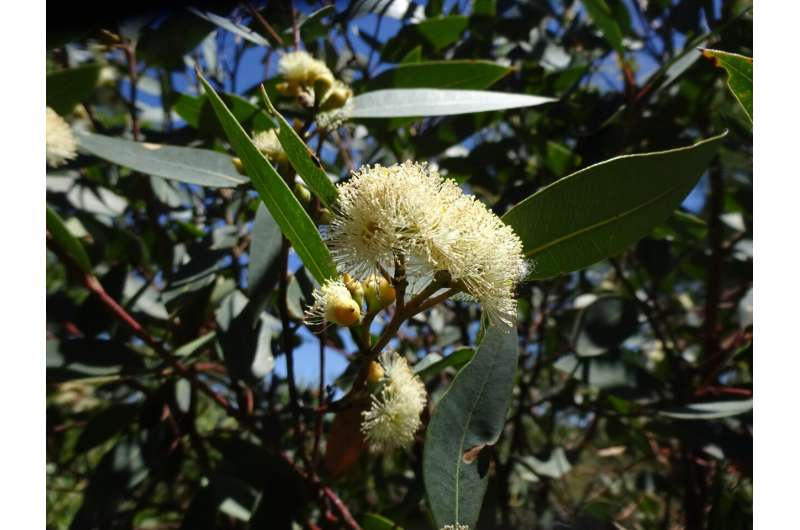Credit: Enhua Lee
Australian Institute of Botanical Science researchers have investigated the hybridization, or crossing of species, of an undescribed eucalypt found in only a few small pockets of Sydney bushland.
In a new paper in Annals of Botany this week they concluded the eucalypt, currently known as Eucalyptus sp. Cattai, should be formally described, after confusion over whether it was a distinctive new species or a peculiar population resulting from the hybridization of two already described species.
"Different plant species can often reproduce with each other and produce viable offspring and we call this hybridization," says Institute Scientist Dr. Trevor Wilson.
"This process can sometimes inadvertently be harmful to the survival of a species, especially when there are few plants or trees left.
"For a long time eucalypt experts haven't known if this is a species or not, even though it is sitting in suburban Sydney, in the Hills District. This tree was found in one of the most densely developed areas of Australia and we still hadn't figured it out.
"It shows you that even on our own doorstep we have things left to be resolved. Our work now shows this tree should be provided with a formal scientific name, and we will be working on this next. Every described species needs a trait to identify its distinctiveness, and in this case genetic data has been a powerful tool to help with this."
In addition to using DNA genomic sequencing to identify that this is a distinct species, researchers used it to investigate genetic variability in the species, allowing them to choose the best cultivated seedlings to help save the species.
"Genetic data can help us to distinguish whether what we are looking at is a distinct species or just the result of hybridization," Dr. Wilson says.
"We also need to look at how prevalent and important hybridization is in a species. In this case we found many of our cultivated seedlings were the result of hybridization between the rare 'Cattai' eucalypt and nearby eucalypts.
"Eucalypts are notorious for being promiscuous and will readily receive pollen from other eucalypt species. They are certainly often not choosy when it comes to mating."
Results from the study were used to help with the translocation of genetically "pure" and healthy cultivated seedlings to nearby suitable habitat.
Researchers found there were only 14 populations of the eucalypt in the Sydney area, with just 700 individuals left in the wild.
The critically endangered eucalypt is restricted to a 40 km2 area of Sydney and is threatened by increased urbanization.
The NSW Government gave it an initial listing as endangered in 1999 before finally declaring it to be critically endangered in 2015.
Dr. Samantha Yap, of the Institute's Research Center for Ecosystem Resilience, says the work has been a collaborative conservation effort between the Institute, Jiangsu University in China and the NSW Government's Saving our Species program.
"For effective conservation, the first step should be to assess what's a rare species and what is not, and a genetic study presents a very effective approach," she says.
"Once it's known to be rare, we must then focus efforts to save it. There can be a lot of roadblocks in the way of species discovery, and that's why many haven't been formally described yet. Recent advances in technology and skills are lending better resolving power to overcome these hurdles.
"This cross-collaborative effort paves the way for the species description and enhances conservation outcomes."
Dr. Wilson says hybridization is a natural phenomenon important with species evolution.
"Plant species can connect and gene share which sometimes gives them evolutionary boost to overcome some challenging environments," he says.
"In the animal world it's a bit rarer but in plants, hybridization is less inhibited between closely related species."
Chief Executive of Royal Botanic Gardens and Doman Trust and the Australian Institute of Botanical Science, Denise Ora, says the collaborative work shows just how vital the Institute's conservation efforts are.
"These are plants right in front of our noses and yet we still have so much work to do if it means conserving species," she says.
"The Institute's work on population genomics has provided valuable insights into evolutionary processes to improve management practices and strategies and save a number of threatened plant species.
"Having knowledge of these evolutionary processes is important for their conservation so we must continue our research efforts to protect our environment for generations to come."
More information: Susan Rutherford et al, Evolutionary processes in an undescribed eucalypt: implications for the translocation of a critically endangered species, Annals of Botany (2022). DOI: 10.1093/aob/mcac091
Journal information: Annals of Botany
Provided by Australian Institute of Botanical Science
























